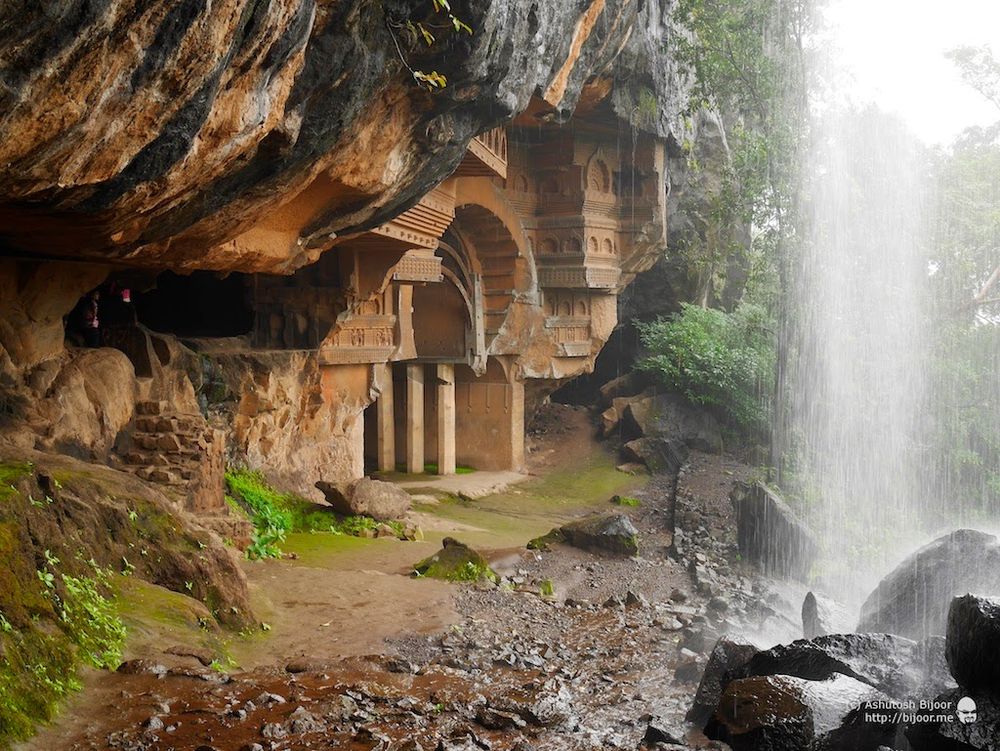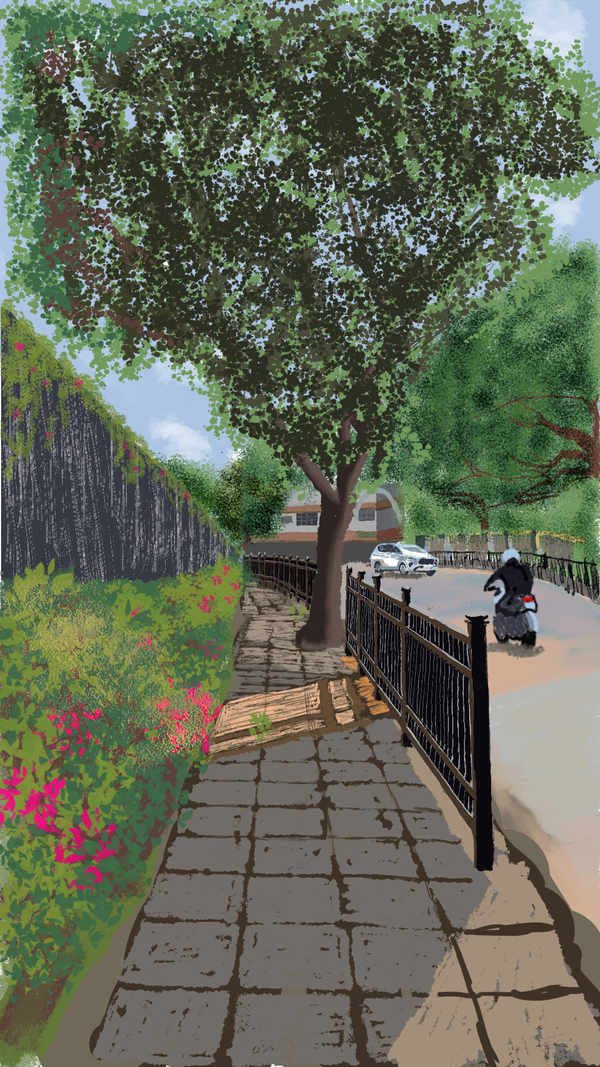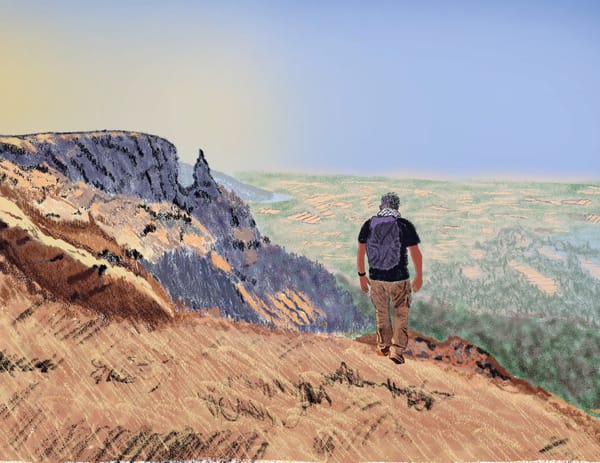Cycling to Kondhane (Kondane) Caves
Kondhane caves is located about 15 kms further south from Karjat, a popular holiday destination just 50 kms south from Sion along the Mumbai Pune National Highway 4. The caves are in the Sahyadri hills, and overlook the Ulhas river very close to its origin, in a valley north of the Rajmachi hills formed by mountain streams draining the northern slope of those hills.
The idea of visiting the caves was initially based on revisiting Rajmachi, where we had done some great mountain biking a few years back. One of the routes to climb up to Rajmachi fort is from Kondhane caves. But I wanted to cycle there all the way and avoid driving to the base like we did previously. Hence I planned to only visit the caves after cycling to the base village of Kondhivde. This was in September, and it was still raining, with the last few days of the monsoon. The weather was great and I did not want to miss a chance at a monsoon ride.
 I cycled along NH4 till Chowk, from where I turned on to SH 79 towards Karjat. However, on the map I noticed a road that leads to the south, to the right from SH 79 just about a kilometer from Chowk junction. This is the road that leads to Bhilavle dam.
I cycled along NH4 till Chowk, from where I turned on to SH 79 towards Karjat. However, on the map I noticed a road that leads to the south, to the right from SH 79 just about a kilometer from Chowk junction. This is the road that leads to Bhilavle dam.
 I reached Bhilavle dam, with the road over the dam leading to across to the other side. Bhilavle is a great place for a picnic if you want to avoid the crowds at Karjat, and is close to the highway
I reached Bhilavle dam, with the road over the dam leading to across to the other side. Bhilavle is a great place for a picnic if you want to avoid the crowds at Karjat, and is close to the highway
 I stopped for a while to admire the beautiful though artificial lake. The monsoon clouds cast their dark reflection in the reservoir, while the cold wind blew across the waters.
I stopped for a while to admire the beautiful though artificial lake. The monsoon clouds cast their dark reflection in the reservoir, while the cold wind blew across the waters.
 On the other end of the dam, the road slopes downwards, and is lined with thick bamboo trees on either side, creating a green arched tunnel under them. But I had a surprise waiting at the end of this green tunnel!
On the other end of the dam, the road slopes downwards, and is lined with thick bamboo trees on either side, creating a green arched tunnel under them. But I had a surprise waiting at the end of this green tunnel!
 As I came out from the bamboo tunnel, I was regaled by the sight and sound of this gushing water fall created by the overflow of the water in the lake!
As I came out from the bamboo tunnel, I was regaled by the sight and sound of this gushing water fall created by the overflow of the water in the lake!
 I went closer to the waterfall and stood admiring the water and the beautiful house located so perfectly next to it. I wonder who is the lucky owner of that place!
I went closer to the waterfall and stood admiring the water and the beautiful house located so perfectly next to it. I wonder who is the lucky owner of that place!
 After Bhilavle, the tar road ends, but continues north towards Palasdari as this mud road. This was an unexpected bonus of an off-road ride for me. I met this bunch of kids returning home from their school (half day on Saturday)
After Bhilavle, the tar road ends, but continues north towards Palasdari as this mud road. This was an unexpected bonus of an off-road ride for me. I met this bunch of kids returning home from their school (half day on Saturday)
 The road winds through open meadows with some large mango trees like this one marking their territory. Thankfully it was cool and cloudy and not at all hot. And though the clouds were loaded and dark, they were holding back the rain.
The road winds through open meadows with some large mango trees like this one marking their territory. Thankfully it was cool and cloudy and not at all hot. And though the clouds were loaded and dark, they were holding back the rain.
 The mud road joins the Karjat Khopoli road. The road surface of this one was even worse than the Chowk-Karjat SH 79, and in fact worse than the mud road! But it was lined on both sides with thick bushes of wild flowers
The mud road joins the Karjat Khopoli road. The road surface of this one was even worse than the Chowk-Karjat SH 79, and in fact worse than the mud road! But it was lined on both sides with thick bushes of wild flowers
 At Palasdari, I turned off the Karjat Khopoli road towards Palasdari station. Again this was a beautiful tree-lined mud road.
At Palasdari, I turned off the Karjat Khopoli road towards Palasdari station. Again this was a beautiful tree-lined mud road.
 When I arrived at the railway line, I asked a few village kids directions to cross to the other side, and they told me to go left to the station and cross the tracks. However, on the map I could see that there was a path leading to the right that seemed to pass under the tracks through a tunnel similar to the one in this picture. I decided to explore that route and avoid crossing the tracks with my cycle.
When I arrived at the railway line, I asked a few village kids directions to cross to the other side, and they told me to go left to the station and cross the tracks. However, on the map I could see that there was a path leading to the right that seemed to pass under the tracks through a tunnel similar to the one in this picture. I decided to explore that route and avoid crossing the tracks with my cycle.
 And sure enough, the path did lead me to a railway crossing. I crossed it hoping that the road would continue beyond and join the tar road on the southern banks of the Ulhas river, leading up to Kondhivde
And sure enough, the path did lead me to a railway crossing. I crossed it hoping that the road would continue beyond and join the tar road on the southern banks of the Ulhas river, leading up to Kondhivde
 But that was not to be. The road ended abruptly at this stream that was flowing through a tunnel under a second set of tracks!
But that was not to be. The road ended abruptly at this stream that was flowing through a tunnel under a second set of tracks!
 Having ventured so far and confident that Google maps cant be that bad, I hoped this was just a temporary flooding of the road that the map confidently showed leading to the other side. I got my shoes off, tied them to the handle and waded through the water. The water was waist deep in the tunnel, and I hoped it got back on to a proper road on the other side.
Having ventured so far and confident that Google maps cant be that bad, I hoped this was just a temporary flooding of the road that the map confidently showed leading to the other side. I got my shoes off, tied them to the handle and waded through the water. The water was waist deep in the tunnel, and I hoped it got back on to a proper road on the other side.
 But what I encountered on the other side was lush green rice fields with a small path leading through them.
But what I encountered on the other side was lush green rice fields with a small path leading through them.
 I continued riding through but soon had to get off and walk because the mud was slushy and my tires dug into it over 6 inches deep
I continued riding through but soon had to get off and walk because the mud was slushy and my tires dug into it over 6 inches deep
 But I managed to get out of the muddy road onto the tar road eventually, and my adventure paid off. I warmed myself with a hot cup of tea and covered the last few kilometers to Kondhivde
But I managed to get out of the muddy road onto the tar road eventually, and my adventure paid off. I warmed myself with a hot cup of tea and covered the last few kilometers to Kondhivde
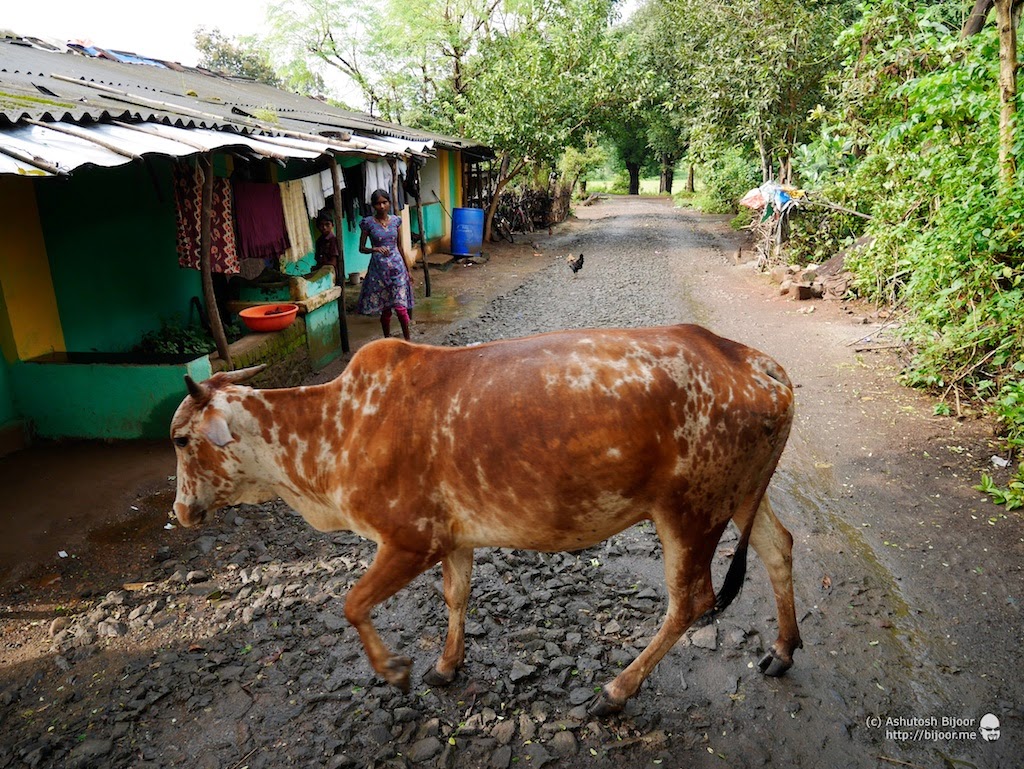 Kondhivde is a small village with a few houses, with hens, cows and kids loitering on the road
Kondhivde is a small village with a few houses, with hens, cows and kids loitering on the road
 I parked my cycle in between two of the houses, requesting the owner to keep an eye on it. The path to the caves is just a few meters away from the houses and leads uphill through thick forest cover
I parked my cycle in between two of the houses, requesting the owner to keep an eye on it. The path to the caves is just a few meters away from the houses and leads uphill through thick forest cover
 The first sight of the caves is dramatic! The caves are cut into this rock face, with a waterfall easing its way down from the cliff above. There are steps cut into the rocks that lead up to the caves.
The first sight of the caves is dramatic! The caves are cut into this rock face, with a waterfall easing its way down from the cliff above. There are steps cut into the rocks that lead up to the caves.
 As you reach the actual caves they are even more breathtaking! The water cascading down fills the air with its gushing sound, drowning out the other sounds of chirping birds in the forest. The caves are just beautiful, and the main Chaitya hall (chaityagriha) is close to where the steps end
As you reach the actual caves they are even more breathtaking! The water cascading down fills the air with its gushing sound, drowning out the other sounds of chirping birds in the forest. The caves are just beautiful, and the main Chaitya hall (chaityagriha) is close to where the steps end
 Kondhane caves were first discovered by Vishnu Shastri in 1850. Kondhane, Bhaja and Karla are caves that are located around Lonavale. In fact, Dr. D. J Wilson in his writings mentions that the name Lonavala may be corruption of Lenavali – or the grove of caves! (ref)
Kondhane caves were first discovered by Vishnu Shastri in 1850. Kondhane, Bhaja and Karla are caves that are located around Lonavale. In fact, Dr. D. J Wilson in his writings mentions that the name Lonavala may be corruption of Lenavali – or the grove of caves! (ref)
 The caves face north-west, and the first excavation to the south-west is a chaityagriha, a large prayer hall 26ft8in wide, 26ft5in high to the crown of the arch. The nave in front of the dagoba (stupa) is 49ft in lendth by 14ft8in, and the dagoba is 9.5ft in diameter. There are seven pillars on either side of the hall, though these are not the original. On the left side is a fragment of a sculpture – part of the head of a single figure whose features are destroyed but the details of the head-dress show the most careful attention to finish of detail. Over the left shoulder is an inscription in one line in Mauryan characters dating to the second century BC or slightly later, which reads “Kanhasa antevashina Balakena katam” which translates to “Made by Balakena, the pupil of Kanha (Krishna)” (ref). There are markings on the side of the roof that indicate that there were wooden ribs set into them, similar to the ones found in the Bhaja caves chaityagriha. The facade has a large horseshoe-shaped arch, supported by curved wooden beams.
The caves face north-west, and the first excavation to the south-west is a chaityagriha, a large prayer hall 26ft8in wide, 26ft5in high to the crown of the arch. The nave in front of the dagoba (stupa) is 49ft in lendth by 14ft8in, and the dagoba is 9.5ft in diameter. There are seven pillars on either side of the hall, though these are not the original. On the left side is a fragment of a sculpture – part of the head of a single figure whose features are destroyed but the details of the head-dress show the most careful attention to finish of detail. Over the left shoulder is an inscription in one line in Mauryan characters dating to the second century BC or slightly later, which reads “Kanhasa antevashina Balakena katam” which translates to “Made by Balakena, the pupil of Kanha (Krishna)” (ref). There are markings on the side of the roof that indicate that there were wooden ribs set into them, similar to the ones found in the Bhaja caves chaityagriha. The facade has a large horseshoe-shaped arch, supported by curved wooden beams.
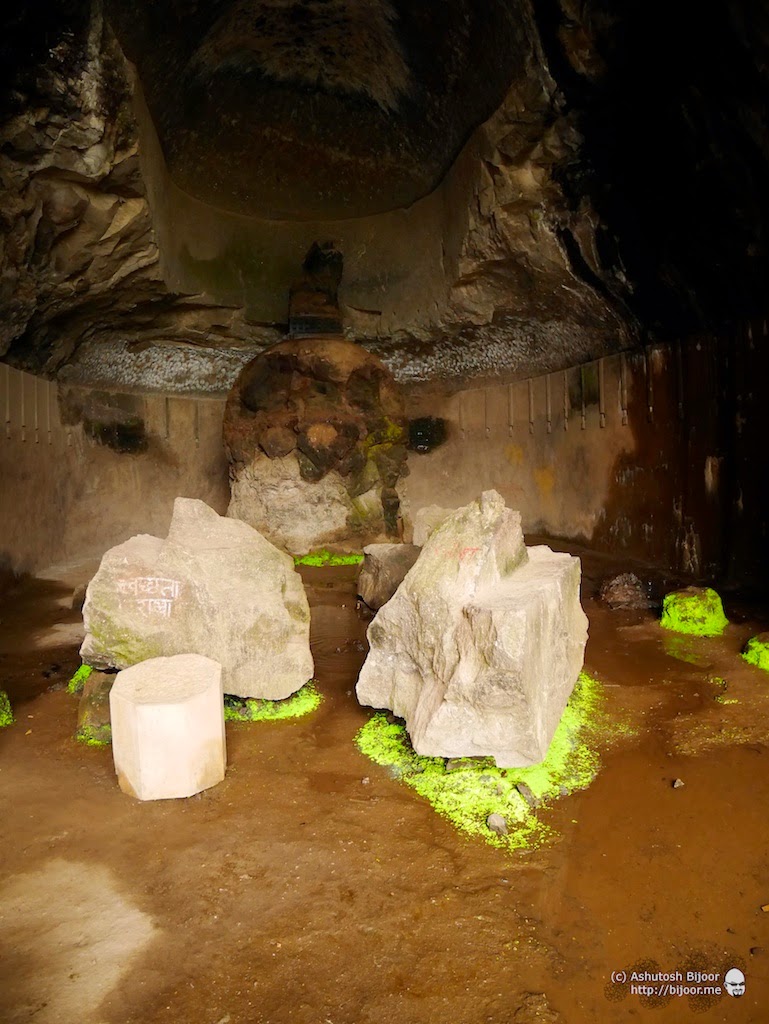 The dagoba or stupa inside the chaityagriha is 9.5 feet in diameter, with a capital on top representing two coffers, one above the other, with carvings on the sides with the Buddhist rail pattern (ref). The stupa is in a damaged condition, and one can see large rock pieces on the floor that could have been part of the roof. A large part of this damage is presumably due to severe earthquakes in the Pune region that occurred between 1752 to 1812 (ref)
The dagoba or stupa inside the chaityagriha is 9.5 feet in diameter, with a capital on top representing two coffers, one above the other, with carvings on the sides with the Buddhist rail pattern (ref). The stupa is in a damaged condition, and one can see large rock pieces on the floor that could have been part of the roof. A large part of this damage is presumably due to severe earthquakes in the Pune region that occurred between 1752 to 1812 (ref)
 The whole portico-area is carved to imitate a multi storeyed building with balconies and windows and sculptured men and women who observed the scene below. This created the appearance of an ancient Indian mansion (ref)
The whole portico-area is carved to imitate a multi storeyed building with balconies and windows and sculptured men and women who observed the scene below. This created the appearance of an ancient Indian mansion (ref)
 The lower portion of this structure is carved with the Buddhist rail pattern, the central portion is divided into seven compartments, filled alternately, three with a lattice pattern and five with human figures – one male in the first, a male and female in each of the third and fifth, and a male with a bow and two females in the seventh. Over these is a band with the representations of the ends of tie-beams or bars projecting through it, and then four fillets, each projecting over the one below, and the upper half of the last is serrated (ref)
The lower portion of this structure is carved with the Buddhist rail pattern, the central portion is divided into seven compartments, filled alternately, three with a lattice pattern and five with human figures – one male in the first, a male and female in each of the third and fifth, and a male with a bow and two females in the seventh. Over these is a band with the representations of the ends of tie-beams or bars projecting through it, and then four fillets, each projecting over the one below, and the upper half of the last is serrated (ref)
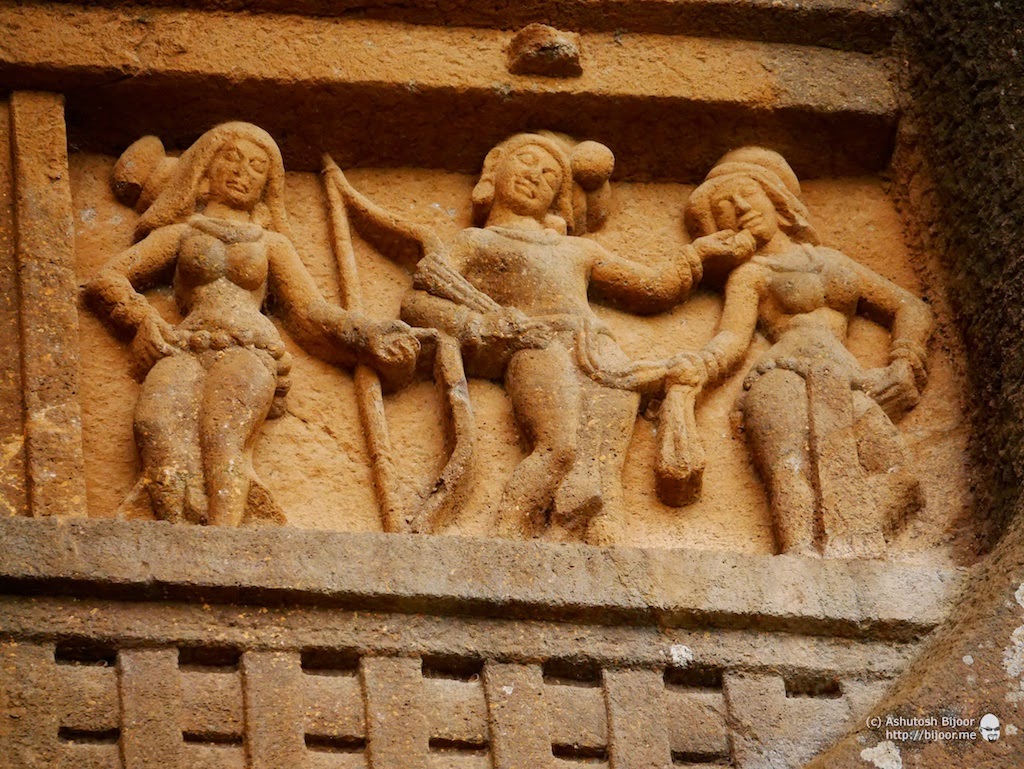 The carvings are truly exquisite, with clearly visible features such as the garments, weapons and ornaments they wore, as well as peaceful happy expressions on their faces. Of particular interest is how the female figures or Yakshinis are depicted. The female form, as a heirophany and locus of magical forces, is emphasized by depicting the figures as nude or minimally clothed with the barest hint of a diaphanous garment and perhaps a sash whose draping reveals rather than conceals. The broad, ornamental girdle (mekhala) around the waist is endowed with magical powers. A hymn in the Atharva veda praises the hip girdle for conferring long life, vigor, wisdom, intelligence and victory. The Yakshinis also serve as protectors of the monument itself. They guard the gates and the perimeter of the sacred precinct (ref).
The carvings are truly exquisite, with clearly visible features such as the garments, weapons and ornaments they wore, as well as peaceful happy expressions on their faces. Of particular interest is how the female figures or Yakshinis are depicted. The female form, as a heirophany and locus of magical forces, is emphasized by depicting the figures as nude or minimally clothed with the barest hint of a diaphanous garment and perhaps a sash whose draping reveals rather than conceals. The broad, ornamental girdle (mekhala) around the waist is endowed with magical powers. A hymn in the Atharva veda praises the hip girdle for conferring long life, vigor, wisdom, intelligence and victory. The Yakshinis also serve as protectors of the monument itself. They guard the gates and the perimeter of the sacred precinct (ref).
 Men and women in the Mauryan and Sunga period wore three unstitched garments, as in Vedic times. The main garment was the antariya of white cotton, linen or flowered muslin, sometimes embroidered in gold and precious stones. For men, it was an unstitched length of cloth draped around the hips and between the legs in the kachcha style, extending from the waist to the calf or ankles or worn even shorter by peasants and commoners. The antariya was secured at the waist by a sash or kayabandh, often tied in a looped knot at the center front of the waist. The kayabandh could be simple sash, vethaka; one with drum-headed knot at the ends, muraja; a very elaborate band of embroidery, flat and ribbon-shaped, pattika; or a many-stringed one, kalabuka. The third item of clothing called uttariya was another length of material, usually fine cotton, very rarely silk, which was utilized as a long scarf to drape the top half of the body (ref)
Men and women in the Mauryan and Sunga period wore three unstitched garments, as in Vedic times. The main garment was the antariya of white cotton, linen or flowered muslin, sometimes embroidered in gold and precious stones. For men, it was an unstitched length of cloth draped around the hips and between the legs in the kachcha style, extending from the waist to the calf or ankles or worn even shorter by peasants and commoners. The antariya was secured at the waist by a sash or kayabandh, often tied in a looped knot at the center front of the waist. The kayabandh could be simple sash, vethaka; one with drum-headed knot at the ends, muraja; a very elaborate band of embroidery, flat and ribbon-shaped, pattika; or a many-stringed one, kalabuka. The third item of clothing called uttariya was another length of material, usually fine cotton, very rarely silk, which was utilized as a long scarf to drape the top half of the body (ref)
 At a slightly higher level to the north-east of the Chaitya is a Vihara – or the living quarters. The hall inside is 23 ft wide and 29 ft deep, and 8ft3in high. It has 15 pillars arranged about 3 feet apart and 3.5 feet from the side and back walls, but none across the front. The upper portions of these pillars are square, but about 1.5 feet from the top they are octogonal. The bases are all gone, but they were probably square as well. The roof is paneled in the imitation of a structural hall with beams running through the heads of the pillars, and the spaces between divided by smaller false rafters (ref)
At a slightly higher level to the north-east of the Chaitya is a Vihara – or the living quarters. The hall inside is 23 ft wide and 29 ft deep, and 8ft3in high. It has 15 pillars arranged about 3 feet apart and 3.5 feet from the side and back walls, but none across the front. The upper portions of these pillars are square, but about 1.5 feet from the top they are octogonal. The bases are all gone, but they were probably square as well. The roof is paneled in the imitation of a structural hall with beams running through the heads of the pillars, and the spaces between divided by smaller false rafters (ref)
 There are three wide doors into the hall, though most of the front wall is broken away. There also was a verandah in front that is all destroyed now except for a small bit at the left end (ref).
There are three wide doors into the hall, though most of the front wall is broken away. There also was a verandah in front that is all destroyed now except for a small bit at the left end (ref).
 This small remaining bit of the verandah has a raised recess, and under a chaitya arch is a small dagoba in half relief – probably the only object of worship when these caves were being excavated (ref). It is sad to see how visitors are defacing these sacred sites.
This small remaining bit of the verandah has a raised recess, and under a chaitya arch is a small dagoba in half relief – probably the only object of worship when these caves were being excavated (ref). It is sad to see how visitors are defacing these sacred sites.
 The view from the cave is of the Bhor ghats on the opposite side of the Ulhas river valley, and if you’re lucky you could see the train chugging along the tracks.
The view from the cave is of the Bhor ghats on the opposite side of the Ulhas river valley, and if you’re lucky you could see the train chugging along the tracks.
 A last look at the caves, with the dramatic waterfall and caves full of stories of an age when Lonavala was Lenavali – the grove of caves!
A last look at the caves, with the dramatic waterfall and caves full of stories of an age when Lonavala was Lenavali – the grove of caves!
But before I left, I did not miss the chance to get under the waterfall, and cleanse myself of the sweat and grime after cycling over 90 kms from Mumbai and through an exciting off-road section full of mud.
 On the way back, I stopped to enjoy the view of these rain water harvesting lakes, dug into the ground while thoughtfully leaving clumps where trees grew. Their reflection in the water, with the monsoon clouds above was a sight that could keep you mesmerized, staring for hours.
On the way back, I stopped to enjoy the view of these rain water harvesting lakes, dug into the ground while thoughtfully leaving clumps where trees grew. Their reflection in the water, with the monsoon clouds above was a sight that could keep you mesmerized, staring for hours.
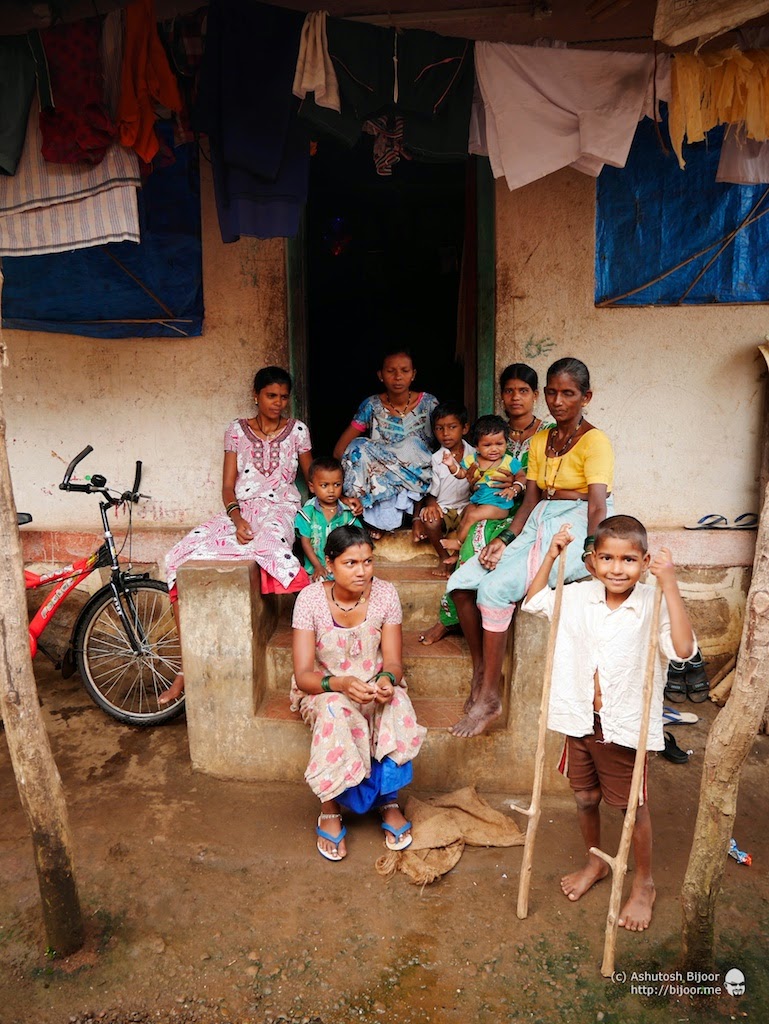 Back in Kondhivade, I spent some time chatting with this family. The women and children were enjoying a break from their daily chores, while the men were out working in the farms.
Back in Kondhivade, I spent some time chatting with this family. The women and children were enjoying a break from their daily chores, while the men were out working in the farms.
This little boy was so full of energy! He had made stilts out of two sticks, and was running at full speed all around me. I managed to capture this picture when he took a rare break in his stride.
 On the way back, it was already 5:30 pm as I had spent over 3 hours at the caves. I thought I would catch the train from Karjat and reach early. However, the station master just would not allow me to get on to the station with the cycle – let alone giving me a ticket. In a huff, I decided I’m going to cycle back home – and that too by taking a longer route via Ambernath and Shil Phata. Well I did reach home, but it was already dark, raining, and my lights were not really prepared for that long ride in the dark. I reached home late, exhausted after a total of over 192 km of cycling and a short trek – but completely satisfied at having spent a day full of adventure and fun!
On the way back, it was already 5:30 pm as I had spent over 3 hours at the caves. I thought I would catch the train from Karjat and reach early. However, the station master just would not allow me to get on to the station with the cycle – let alone giving me a ticket. In a huff, I decided I’m going to cycle back home – and that too by taking a longer route via Ambernath and Shil Phata. Well I did reach home, but it was already dark, raining, and my lights were not really prepared for that long ride in the dark. I reached home late, exhausted after a total of over 192 km of cycling and a short trek – but completely satisfied at having spent a day full of adventure and fun!
I had done this ride in September. The reason I took so long to post this was that I had found very little information about the history of the caves. But after a long search I managed to find this book “The Cave Temples of India” by James Burgess, published by W. H. Allen & Company. And the best part is, the e-book version is available free of cost on Google Play! Do not miss checking out this e-book!.

